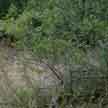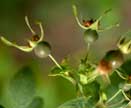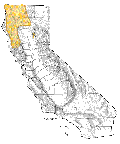



| Description | Distribution | Discussion | Horticultural Notes | Nomenclature | Links |

| 
| 
|  |
| Lank shrub at edges of or in open forest understory. | Prickles few, paired at nodes, straight, somewhat thick-based. | Flowers usually several per inflorescence. | Hips globose with elongate sepal-tips. |

| Northern Coast Ranges and Klamath/Siskiyou Ranges in northern California, extending north on the west side of the Cascades to British Columbia. Additional distributional representations available from links at entry for this species in the Jepson Interchange for On-Line Floristics |
Possible Synonyms (working list):
R. copelandii Greene, Leafl. Bot. Observ. Crit. 2: 264. 1912: Copeland [Baker 3875]-- Mt Eddy, Siskiyou Co., CA (HT: NDG11152!; ISO: CAS! MO! NY! US!)
R. corymbiflora Rydb., N. Amer. Fl. 22: 519. 1918: Eastwood 1404-- between Pitt & Baird, Shasta Co., 25 Jul 1912 (HT: Arnold Arb.; IS: NY!)
R. eastwoodii Rydb., N. Amer. Fl. 22: 527. 1918: Eastwood 2100-- Sisson, Siskiyou Co, CA, 4 Sep 1912 (HT: Arnold Arb.; IS: CAS! NY!)
R. pringlei Rydb., Bull. Torrey Bot. Club 44: 79. 1917: Pringle s.n.-- Siskiyou Co. , CA (HT: NY!; IS: US!)
R. rivalis Eastw., Bull. Torrey Bot. Club 32: 198. 1905: Eastwood s.n.-- Laytonville [see discussion in Rydb., 1917]